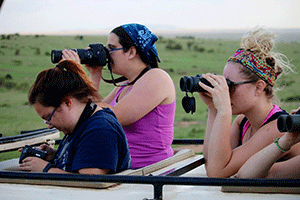Name: Clara Lepard
Status: Senior
Majors: BS Zoology, Minoring in Environmental and Sustainability Studies
Hometown: East Lansing, Michigan
Program: Behavioral Ecology of African Mammals, Kenya

We're standing barefoot on the seats of the jeep, notebooks resting on the roof in front of us, doing our best to stifle our laughter and collect accurate data. We are in the Central Plains of the Maasai Mara, the most famous national reserve in Kenya. It's the evening game drive of the day, so the sun is slowly making its way to the horizon, casting everything in a golden wash of light that I love to capture with my camera. But for now my mind isn't on photography – my project partner and I are in the middle of data collection for our final project. We are observing a herd of impala, grazing in the middle of an acacia bushland. They've become commonplace to me after seeing them so often during this program, but even now I think back on the fact I had never seen these animals in the wild just a few weeks ago and smile. They are one of the amazing facets of this landscape that we don't often hear about at home. We always get close-ups of lions roaring and leopards blinking out of a tree, and elephants majestically walking out of the sunset, but there is so much more here to take in. One of the individuals I'm recording data on is the harem leader, whose spiraling horns are silhouetted against the sky, towering over the rest of this antelope's gracefully built body. Surely, these creatures are just as worthy of a National Geographic cover as a snarling big cat.
Another loud snort is heard from somewhere behind us, and my partner and I break down into giggles again. A herd of topi, significantly less graceful than the impala (but perhaps even more loveable for their simple nature), is also grazing in this area. They are also much more alarmed by our experiment than the impala seem to be. For in the middle of this idyllic landscape, there stands a misshapen bundle of sticks, held together by black string. Some brown fabric, with spots drawn on it in sharpie, gives the bundle the rough appearance of a hyena. The bundle is 'Charlie', the visual model we built by hand for our project, to see how antelopes react to a predator being nearby. The Maasai guards back at camp were thoroughly amused by him, and some even helped build him when they saw us struggling. While the impala seem less than impressed by our hard work, the topi are thoroughly convinced, and we are endlessly entertained by their alarmed snorts (which sound like a chorus of half-hearted whoopee cushions) all around us. The other students in the back of the jeep are also giggling, and one of our fearless grad student leaders shakes her head at our silliness. Our trusty guide and driver, Chris, is also smiling at the scene.
This is studying abroad. It's saturated with brand new sights and experiences, but a shared laugh and some silliness will make any place feel like home.